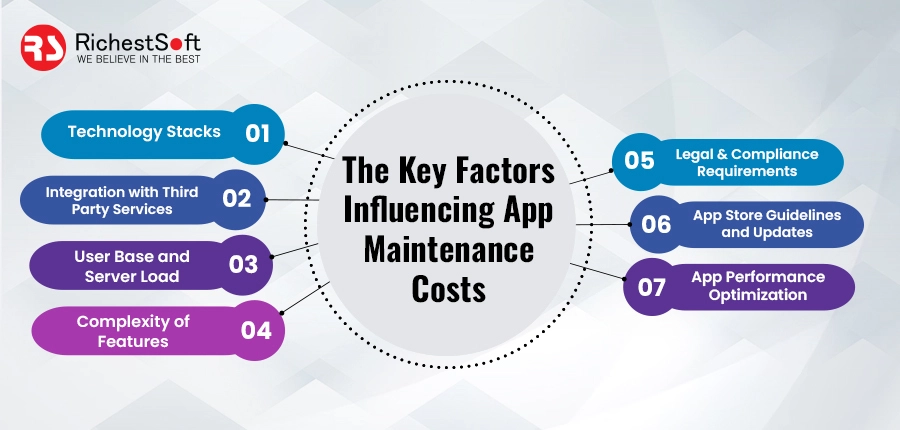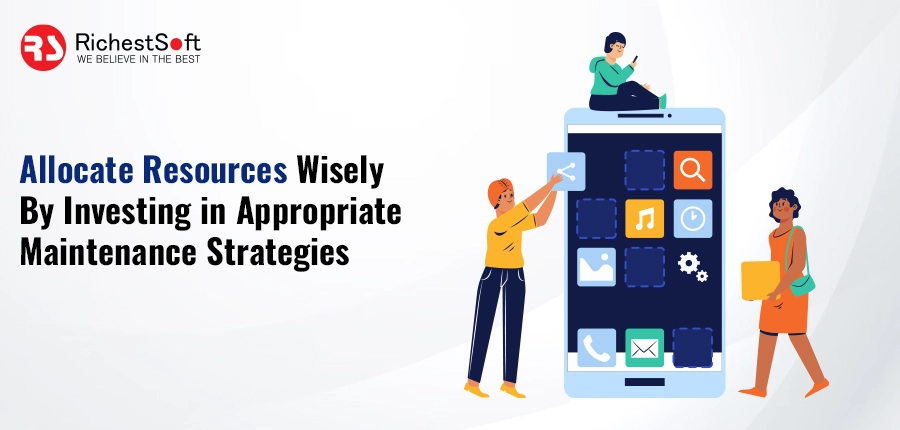Introduction
Mobile applications have become an indispensable part of our daily lives in the rapidly evolving world of technology. From managing finances to ordering groceries, apps have transformed how we interact with the digital world. However, creating a profitable app is just the beginning of the process.
App maintenance is mandatory to ensure a seamless user experience, bug patches, updates, and overall app functionality. In this article, we will delve into the importance of app maintenance, explore the diverse facets of mobile app maintenance, discuss the app maintenance cost implications based on different tech stacks and user bases, examine regional differences, and provide tips to minimize maintenance expenses.
Why is App Maintenance Important?
App maintenance encompasses various activities essential for an application’s long-term success. Regular updates help improve performance, enhance security, fix bugs, and address compatibility issues with new operating systems or devices.
Furthermore, maintenance helps programmers integrate user input, introduce new features, and guarantee that the app maintains relevance in an ever-changing market. Businesses can create a flawless user experience, sustain client loyalty, and remain ahead of their rivals by committing to app maintenance.
Exploring the Diverse Facets of Mobile App Maintenance
👉User Feedback and Scalability:
User Feedback: Collect and analyze user feedback to guide maintenance efforts.
Scalability: Optimize app architecture and infrastructure for growing user loads.
👉Technical Complexity:
App Complexity: Consider the complexity of features and code structures in maintenance costs.
👉Security and Data Privacy:
Security: Regular audits and measures to protect against vulnerabilities and threats.
👉Data Privacy: Ensure compliance with regulations and protect user data.
👉Operating System Updates:
Operating System Compatibility: Maintain compatibility with new OS versions.
👉Device Compatibility:
Device Fragmentation: Address device-specific challenges for optimal app performance.
Exploring the points in detail
✅User Base and Scalability
The user base’s size and growth directly impact an app’s maintenance needs and costs. As an app gains popularity and attracts more users, it may experience increased server load, bandwidth requirements, and demand for updates and bug fixes.
Maintenance efforts need to focus on scaling the infrastructure, optimizing server resources, and ensuring the app can handle the growing user base without compromising performance or user experience. Additionally, apps that rely on third-party services or cloud platforms may have varying maintenance costs based on those services’ usage and pricing structure.
✅User Feedback and Feature Enhancements
User feedback is invaluable for improving app functionality and user experience. App maintenance includes reviewing user feedback, analyzing usage patterns, and incorporating user suggestions to enhance the app’s features and usability.
This iterative approach to maintenance ensures that the app remains relevant, competitive, and aligned with user expectations. Regularly implementing user-requested features and addressing usability issues through maintenance updates can significantly be presented user satisfaction and long-term app success.
✅Technical Complexity
The technical complexity of an app plays a crucial role in determining its maintenance requirements and costs. Apps built with different programming languages and frameworks have varying levels of complexity. For example, apps developed using cross-platform app development frameworks like Flutter or React Native can offer cost advantages in maintenance.
These platforms create code once and distribute it across several platforms, avoiding the requirement for several platform maintenance activities. Apps designed with native languages such as Swift or Java/Kotlin, conversely, may necessitate more specialist maintenance knowledge, as upgrades and bug fixes must be performed individually for iOS and Android platforms.
✅Security and Data Privacy
In the age of increasing cyber threats, app maintenance must prioritize security and data privacy. Regular maintenance updates should include security patches to address vulnerabilities and protect user data. App maintenance involves monitoring security trends, staying updated on best practices, and implementing necessary measures to safeguard user information. It can include encryption techniques, secure authentication mechanisms, and compliance with data protection regulations such as GDPR or CCPA.
✅Operating System Updates and Device Compatibility:

App maintenance becomes essential to ensure compatibility as mobile operating systems evolve and release new versions. Updates to operating systems may introduce changes that affect the functionality or performance of an app.
App maintenance involves monitoring and adapting the app to work seamlessly with new operating system versions, ensuring compatibility across various devices and screen sizes. It may involve adapting the user interface, addressing compatibility issues, and optimizing performance for the latest devices and operating system features.
App Maintenance Cost: Based on the App’s Tech Stacks and User Base.
The technological stack used throughout the development phase and the scope of the consumer base impact the app maintenance cost. Additional factors to take into account when assessing app maintenance expenses depending on the technology stack and customers are as follows:

✔️Technology Stacks:
The choice of app technology stack can have an impact on the app maintenance cost. The setting, means of development, and support from the public are unique to each technological stack. Here are a few instances:
React Native: Another well-liked cross-platform structure, React Native enables programmers to create native-app-like applications for Android and iOS employing JavaScript. Because updates and bug patches may be deployed to both systems, the cost of upkeep for React Native applications may be comparable to that of Flutter. The typical yearly upkeep expense for a React Native app varies between $12,000 to 55,000 dollars, based on the level of detail of the project and the requirement for platform-specific changes.
Flutter: Using just one code base, developers can create programs for Android and iOS, applying the well-liked cross-platform technology Flutter. Flutter apps often have cheaper maintenance costs than maintaining individual native apps for all platforms.
It is so that maintenance can be done more quickly and with less work, as updates and corrections for problems may be deployed to everything. According to the intricate nature of the application and the frequency of updates, the cost of sustaining a Flutter app could vary from ten thousand dollars to fifty thousand dollars annually.
Native Android (Java/Kotlin): Java or Kotlin-developed native Android apps require platform-specific maintenance methods. Among these include:
- Fixing conflicts with fresh iterations of Android.
- Installing updates and bug patches.
- Assuring top performance across various devices.
Depending on the convoluted nature of the program and the need for continual enhancements, the upkeep price of native Android apps might change. Keeping a native Android application accurate and up to date, fixing bugs, and being compatible with new Android operating systems can cost anything from $18,000 and $70,000 each year.
Swift: iOS apps are created using the Swift programming syntax. If you have a Swift-based app, the maintenance cost would typically involve updates and bug fixes specific to the iOS platform. The cost might change depending on the depth of the program and the requirement for ongoing enhancements. Using frequent upgrades and bug patches, the average cost of sustaining an iOS app created using Swift ranges from fifteen thousand dollars to sixty thousand dollars.
✔️Integration with Third-Party Services:
Applications that substantially integrate services or APIs from third parties could have higher maintenance expenses. These connections may need regular upgrades to maintain functioning, fix compatibility concerns, and respond to alterations in third-party systems. The cost of upholding these connections varies according to their complexity, how frequently third-party suppliers release updates, and if continuing maintenance and compatibility tweaks are required.
✔️User Base and Server Load:
The size of the user base and the app’s server load can also impact the maintenance cost. Apps with millions of users and high server load require additional resources to ensure smooth functioning.
Suppose the software depends on online computing resources like those provided by Amazon Web Services (AWS). In that case, its upkeep cost may include server growth, archived data, bandwidth utilization, and network administration charges. Various factors, including the volume of data delivered, the number of servers being deployed, and any additional services, may affect how much employing AWS services will cost.
✔️The Complexity of Features:
The complexity of the app’s features can impact the maintenance cost. Apps with intricate functionalities and advanced features may require more time and effort to maintain compared to manageable apps. Complex features often involve:
- More lines of code.
- Dependencies on external services or APIs.
- Integration with third-party systems.
Maintenance costs for such apps may be higher due to the need for continuous updates, bug fixes, and compatibility adjustments as the app evolves.
✔️Legal and Compliance Requirements:
Certain apps, particularly those handling sensitive user data or operating in regulated industries, must comply with specific legal and privacy requirements. Maintaining compliance with GDPR, HIPAA, or PCI-DSS regulations may involve regular audits, security assessments, and updates to ensure data protection and privacy. App maintenance costs can increase when additional measures are required to meet these legal and compliance obligations.
✔️App Store Guidelines and Updates:
Both Apple App Store and Google Play Store have specific guidelines and requirements for app updates. App maintenance often involves adhering to these guidelines and implementing necessary updates to ensure compliance. The cost can vary based on the frequency and complexity of updates required to meet the guidelines. Additionally, extensive operating system updates may require modifications to the app to maintain compatibility, which can impact the maintenance cost.
✔️App Performance Optimization:
Monitoring and improving an app’s performance is necessary for a flawless user experience. Analyzing application usage trends, locating efficiency bottlenecks, and minimizing energy and code usage are a few examples of how to do this. The maintenance cost may increase if the app requires frequent performance optimizations or specific performance challenges must be addressed.
Cost Analysis for High-Usage App Maintenance with AWS Server Load
What Would Be the Cost to Maintain an App that Has Millions of Users and Needs a Huge Server Load Like AWS Services?

👉Additional AWS Services:
Additional AWS services may be employed for enhanced functionality or improved performance, depending on the app’s requirements. For example, apps with extensive media content may leverage Amazon CloudFront for content delivery, while those requiring real-time data processing might employ Amazon Kinesis. Each extra service has a different price range and may raise the overall maintenance cost.
With numerous factors, such as the level of service and the assets required, monthly costs might range from a couple of dollars to a few hundred or even several thousand dollars.
👉Load balancing and server scaling:
To handle a large user base and heavy server load, the app’s infrastructure needs to be scalable and capable of distributing the load efficiently. It may involve implementing auto-scaling mechanisms, load balancers, and optimizing server configurations.
It can be expensive to scale infrastructure using Amazon Web Services like Amazon EC2 (Elastic Compute Cloud) or Amazon Elastic Containers Services (ECS), depending on how many instances or boxes are needed to accommodate the demand.
Given how many instances and containers are needed to manage the load effectively, installing auto-scaling methods and load-balancing systems on AWS services such as Amazon’s EC2 and Amazon ECS might cost anything from a handful of hundreds to many thousand bucks per month.
👉Backups and Disaster Recovery:
Maintaining regular app data backups and having a disaster recovery plan are crucial for business continuity. AWS provides backup and recovery services like Amazon S3 Glacier or Amazon Elastic Block Store (EBS) snapshots. The cost of maintaining backups and implementing disaster recovery measures varies depending on factors such as data size, retention period, and the chosen AWS services.
👉Data Storage and Transfer Costs:
Apps with a large user base produce significant volumes of information that have to be delivered and stored. AWS offers Different storage alternatives, including Amazon Simple Store Services (S3) and Amazon Database Service (RDS), and they have associated prices depending on the amount of data stored, the number of input/output processes, and the amount of data transmission bandwidth. The cost of maintenance rises as data volume and interactions with users develop.
Data transfer costs typically range from $0.09 to $0.15 per gigabyte for outbound traffic, but it may vary depending on the AWS region and the total volume of data transferred.
👉Monitoring and Alerting:
Maintaining the app’s stability and performance requires proactive monitoring and timely issue detection. AWS offers monitoring services like Amazon CloudWatch, which provides metrics, logs, and alerts. However, additional costs may apply based on the frequency of monitoring checks, the number of monitored resources, and the use of premium features. Ensuring adequate monitoring coverage can help promptly identify and address performance bottlenecks, security vulnerabilities, or service disruptions.
👉Bandwidth Usage:
Apps with a massive user base and high server load often consume significant bandwidth. The movement of user inquiries, app answers, pictures, and any additional data transferred between customers and the application’s infrastructure is all subject to AWS costs for incoming and outgoing data transfer. The expenses of maintaining an app’s bandwidth increase with how much data it uses.
Based on the AWS area and the total quantity of data transported, the price of bandwidth use could vary from $0.09 to twenty-five cents per GB.
- It is crucial to remember that without specifics, estimating the actual maintenance costs for an application with billions of consumers and a significant server load using AWS services might be difficult. The price can vary based on the app’s architecture, usage patterns, geographic distribution, and the specific AWS services employed.
- To gain a more accurate estimate, consulting with AWS experts or engaging with a reputable managed service provider who can assess the app’s requirements and tailor an appropriate AWS infrastructure setup while considering cost optimization strategies is advisable.
What is the App Maintenance Cost Based on Different Regions?

👉Middle East and Africa:
Based on the particular nation and its economic environment, app maintenance costs differ throughout the Arabian Peninsula and Africa. Costs may be greater than in other countries in the area, including the power source United Arab Emirates (UAE) and the Republic of South Africa, where the technology sector is expanding. In the Middle East and Africa regions, prices typically vary from $40 to $120 per hour.
👉North America:
Compared to other locations, North America has more powerful app maintenance costs. The increasing cost of living and a great need for qualified mobile app developers are the primary causes of this. Costs can be much higher than the worldwide average in areas with plenty of tech enterprises and people, like Silicon Valley. In North America, maintenance prices for construction and upkeep services typically vary from eighty dollars to three hundred dollars an hour.
👉Asia:
The app maintenance cost is often lower in Asia than it has been in North America and Europe. Lower wages and a fiercely competitive market are the leading causes of this. There is a sizable pool of competent developers in nations like Vietnam, China, and India at comparatively cheaper costs. In Asia, maintenance expenses typically run between $30 and $100 per hour. It’s crucial to remember, too, that prices might change considerably throughout Asian nations as well.
👉Latin America:
Latin America has emerged as a growing mobile app development and maintenance service hub. Compared to North Europe and the United States, the area has a considerable cost advantage and a talented pool of professional developers. In Latin America, maintenance expenses often run between forty and one hundred and fifty dollars per hour. The app development market has expanded significantly in nations like Brazil, Mexico, and Uruguay, offering affordable business options.
👉Europe:
When compared to the United States and Canada, app maintenance costs are often a small-scale cheaper in Europe. The cost variations can be attributed to differences in labor costs, market competitiveness, and regional economic factors. On average, European costs range from $60 to $200 per hour. However, considering their specific market characteristics, several European nations may have substantial or lower expenses.
It’s crucial to remember that these price ranges are only estimates and may change depending on the app’s intricacy, the creative team’s knowledge and expertise level, and project-specific needs. Besides the pricing element, organizations should examine the quality of the services given, the past performance of the growth team, and the total value delivered.
Check Out 4 Tips: How to Minimize Mobile App Maintenance Cost

Minimizing mobile app development costs is a top priority for businesses operating on a tight budget. Fortunately, several savvy strategies can help you trim those expenses without compromising quality. Let’s explore some constructive approaches to help you keep your mobile app development costs at a minimum.
✅Carefully strategize the app’s lifecycle from the very beginning.
Planning its lifecycle is crucial to managing your app’s development and maintenance effectively. Please consider your app’s long-term development, particularly the enlargement of its capabilities and features over time. This insight will allow you to choose between hiring a team of mobile app developers abroad or forming an in-house creation and upkeep staff. By carefully aligning resources and timelines, you can ensure your app project’s smooth and timely completion.
Planning the lifespan of the app before starting production is crucial. The many phases of development, release, and post-launch maintenance are all considered by a well-defined application lifecycle. You may foresee future demands by properly outlining this lifecycle and allocating funds accordingly. With this proactive strategy, you can optimize the use of resources, expedite the app creation procedure, and guarantee an excellent user experience from beginning to end.
✅Leverage the benefits of outsourcing for mobile app development and maintenance.
One of the most efficient ways to minimize your app maintenance cost is by entrusting the process to a specialized external company. Doing so allows you to tap into their expertise and take advantage of their scalable resources. With their proficiency and streamlined processes, they can efficiently accomplish the task within a shorter timeframe while ensuring top-notch quality. This approach allows you to achieve cost savings without compromising on the outcome.
✅Embrace cross-platform app development to optimize cost efficiency.
The benefit of the development of cross-platform applications is that it allows developers to reuse one source code repository to produce apps that work across many operating platforms. This strategy reduces the need for duplicate evaluation and creation activities, boosting productivity. Moreover, performing a single maintenance activity allows you to seamlessly update multiple app variants, saving time and effort in the long run.
✅Allocate resources wisely by investing in appropriate maintenance strategies.

Implementing mobile app maintenance requires a deliberate and thoughtful approach. It is crucial to determine the specific type of maintenance your app requires and establish a suitable frequency for those activities. You can effectively allocate the necessary resources, budget, and time to address maintenance needs. This proactive planning helps prevent last-minute decisions that can lead to inflated costs, ensuring a more streamlined and cost-effective mobile app maintenance process.
FAQs
Q1: Can I perform app maintenance myself?
Ans: While minor updates and bug fixes can be handled internally, working with experienced app developers or a dedicated maintenance team for complex maintenance tasks is advisable. They possess the knowledge to resolve pressing problems, guarantee platform compatibility, and deliver prompt service.
Q2: How frequently must my mobile app be updated?
Ans: User feedback, bug repairs, updates for security, and the introduction of new features are just a few of the variables that influence how frequently an app is updated. Generally, it is advised to deliver updates often to improve user experience, fix any problems, and keep up with the most recent platform needs. The precise update schedule, however, may change depending on your program’s difficulty level, user expectations, and industry norms. Regularly evaluating user feedback and monitoring app performance can help determine the ideal update frequency for your mobile app.
Q3: How do I ensure data security during app maintenance?
Ans: Data security is crucial during app maintenance to protect user information and maintain trust. Here are some top recommendations to guarantee data security:
- Implement secure communication protocols and encryption techniques.
- Regularly update and patch software and libraries to address any security vulnerabilities.
- Adhere to industry-standard security procedures and appropriate data protection laws.
- Use multi-factor authentication to secure access to backend systems.
- Conduct security audits and penetration testing to identify and address potential risks.
- You can protect user data, uphold the reliability and credibility of your smartphone application, and continue to uphold data security priorities while doing app maintenance.
Conclusion
The success and durability of an application for mobile devices depend heavily on its upkeep. Businesses can make informed decisions about in-house development teams or outsourcing to reduce costs by planning the app’s lifecycle.
Outsourcing mobile apps to external experts can provide scalable resources and efficient task completion. Cross-platform app development can optimize cost efficiency by reusing code across multiple operating systems. Investing in the equitable type of maintenance is crucial, allocating the appropriate resources, time, and money.
Regular updates, data security measures, and addressing user feedback are vital components of effective app maintenance. By following these strategies and best practices, businesses can maintain their apps efficiently, minimize app maintenance costs, and provide a seamless user experience.






Leave a Reply